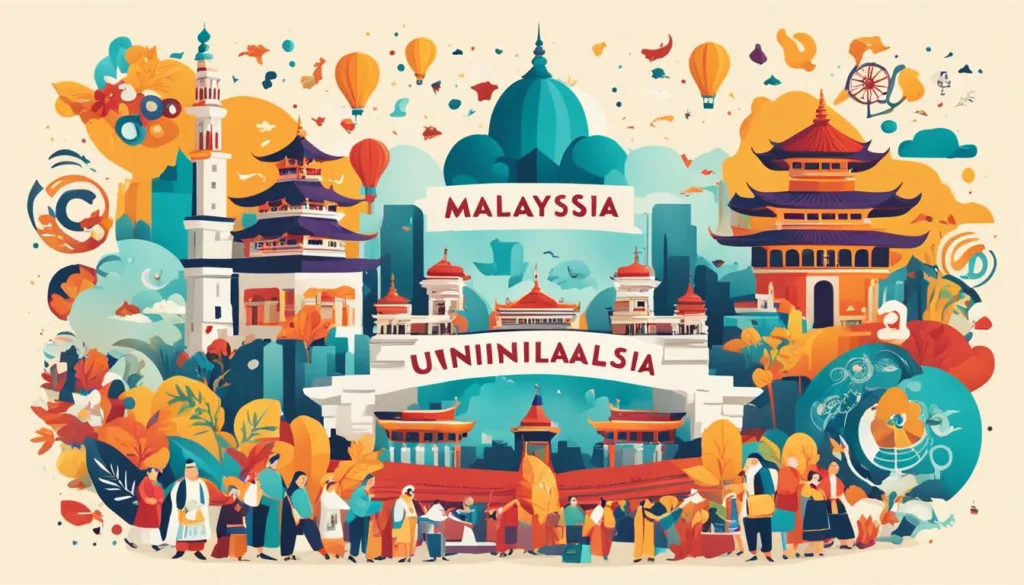Amidst the hustle and bustle of Malaysia’s thriving cities and its lush, biodiverse landscapes, lies an equally vibrant multilingual society where an astonishing number of languages flourish. Home to a tapestry of languages spoken by its vast array of ethnic communities, Malaysia boasts no less than 137 living languages. Among these, the official languages Malaysia has appointed show an admirable commitment to cultural inclusivity with Malay serving as the mother tongue for the Malay ethnic group, and English widely used and formally recognized. In addition to languages spoken Malaysia also offers educational initiatives backing its multiethnic nature with Malay, Mandarin, and Tamil being prominently featured amongst educational settings. Embrace the intricate weave of language diversity Malaysia showcases, a true testament to the nation’s rich cultural ethos.
Key Takeaways
- The official language of Malaysia is Standard Malay or Bahasa Malaysia, integral to the Malay ethnic group.
- English retains an official status in certain domains, reflecting Malaysia’s historical colonial ties and present-day global engagements.
- A staggering 137 living languages are present, with a significant number spatially distributed across Peninsula Malaysia and East Malaysia.
- Government-sponsored educational initiatives support instruction in Malay, Mandarin, and Tamil, mirroring the primary ethnic compositions.
- Language diversity Malaysia experiences is further enriched by indigenous dialects and languages from the Chinese and Indian communities.
- Despite the vast linguistic scape, efforts continue to uphold language preservation and educational development, particularly for indigenous dialects.
Malaysia’s Linguistic Landscape
Malaysia presents a fascinating linguistic mosaic reflective of its diverse cultural history. The languages spoken in Malaysia span across several language families, contributing to the wide spectrum of language diversity Malaysia is known for. Integral to this diversity are the numerous indigenous languages of Malaysia, which play a key role in the cultural identity of the nation’s ethnic communities.
The Malayic language family, which includes the national language, Malay, is just the tip of the linguistic iceberg. Other language families such as North Bornean, Melanau-Kajang, Aslian, Land Dayak, and Sama-Bajaw add depth to Malaysia’s linguistic profile. This linguistic variety is not only a testament to the nation’s rich cultural tapestry but also illustrates an ongoing dialogue between ethnicities and languages.
Concentrated primarily in East Malaysia, languages like Iban, Dusunic, and Kadazan are among the most spoken and play a significant role in the day-to-day lives of their communities. The constitution of Malaysia shines as a beacon of linguistic inclusivity, recognizing the importance of these languages in fostering national harmony.
- Iban: The most widely spoken indigenous language in Malaysia.
- Dusunic: A group of languages that encapsulate the cultural essence of the Kadazan-Dusun people.
- Kadazan: Alongside Iban, a dominant native language that carries significant cultural weight.
Malaysia’s commitment to uphold and respect its linguistic plurality is a model for navigating the complexities inherent in such diversity. The enduring presence and recognition of indigenous languages is central to the country’s identity, ensuring that the voices of all Malaysians are heard and valued.
Languages Spoken Malaysia: An Overview
The linguistic tapestry of Malaysia is vibrant, encompassing more than 130 distinct languages that echo the multi-ethnic mosaic of the nation. Beyond the widely spoken languages in Malaysia, such as Malay, English, Mandarin, and Tamil, there exists a wealth of Malaysian dialects and indigenous languages Malaysia that contribute to the nation’s rich cultural identity. Each language and dialect offers a window into the varied historical and cultural narratives that have come to define Malaysia.
Present within the linguistic landscape are native Malayic tongues and Aslian languages, each with their own unique colloquialisms and rich oral traditions. Beyond these, regional dialects of Malay add further dimension to the conversation, integrating local vocabulary and phrasing that vary from state to state. The influence of foreign languages, due to historical trade and immigration, has also left an indelible mark, introducing creoles and pidgins to the spectrum of spoken language in Malaysia.
Education plays a pivotal role in preserving linguistic diversity, with Malay, Mandarin, and Tamil forming the cornerstone of the Malaysian educational system. Yet even with institutional support, numerous languages face challenges of survival, standing on the brink of extinction. Languages such as Kenaboi and Wila’ now serve as somber reminders of the delicate nature of linguistic heritage and the incessant need for preservation efforts.
Table: Snapshot of Linguistic Diversity in Malaysia
| Language Group | Examples | Region |
|---|---|---|
| Native Malayic Tongues | Standard Malay, Kelantanese, Sarawak Malay | Throughout Malaysia |
| Aslian Languages | Temiar, Semai, Jah Hut | Peninsular Malaysia |
| Foreign Influences | English, Mandarin, Tamil | Urban Areas and Schools |
| Creoles and Pidgins | Manglish, Chavacano | Various Regions |
| Endangered Languages | Kenaboi, Sabüm | Rural Enclaves |
The pursuit of linguistic conservation is as much about honoring the past as it is about shaping a future where each voice, no matter how seemingly small, can resonate with the beauty of its heritage. In bringing attention to the indigenous languages of Malaysia, from the verdant landscapes of East Malaysia to the bustling cities of the Peninsula, steps can be taken to ensure that these vital threads in the nation’s cultural fabric are not lost.
Malay: The National Language of Malaysia
The Malay language, known locally as Bahasa Malaysia, holds the esteemed position of being the official language of Malaysia. Its role extends beyond mere communication, symbolizing unity among Malaysia’s diverse ethnolinguistic groups. Recognizing the vast array of Malaysian Malay dialects offers insight into the cultural tapestry that defines this Southeast Asian nation.
Standard Malay: Uniting a Diverse Population
Standard Malay, governed by intricate rules and formalities, is widely used in governmental and educational spheres. Its standardization has been essential in uniting Malaysians from different backgrounds under one linguistic umbrella. This language provides a shared identity for all Malaysians while preserving open respect for the cultural nuances within the population.
Malaysian Malay Dialects: Regional Variations
Despite the predominance of Standard Malay, the linguistic landscape of Malaysia is enriched by a multitude of Malaysian Malay dialects that capture the regional charisma of the country. From the distinctive Kelantanese in the northeast to the mellow lilt of Kedah Malay in the northwest, each dialect represents a unique imprint of the local communities’ histories and traditions.
| Dialect | Region | Distinguishing Feature |
|---|---|---|
| Kelantanese | Kelantan | Marked intonation and vocabulary unique to the region |
| Terengganu | Terengganu | Rhythmic accentuation, often considered melodious |
| Kedah | Kedah | Softer pronunciation of words, presence of Thai borrowings |
| Sarawak | Sarawak | Usage of Indonesian-like phrases, reflecting its geographical ties |
| Perak | Perak | Unique colloquial expressions, slower speaking speed |
| Bruneian Malay | East Malaysia | Similar to Standard Malay with slight variations in lexicon |
Through education and official channels, the Malay language serves as the keystone of language policy in Malaysia, maintaining its status as one of the official languages of Malaysia. This significant role of the Malay language in the national identity illustrates its importance and inspires efforts to document and preserve its dialectical variety.
In essence, the Malay language in its standardized form and its regional dialects encapsulate the essence of Malaysia’s linguistic heritage. Each dialect stands as a testament to the distinct regional and cultural practices that thrive within the Malaysian ethos. Understanding the full spectrum of Malaysian Malay dialects is not just an academic exercise, but a celebration of the nation’s linguistic diversity.
English in Malaysia: A Legacy of Colonialism
The prevalence of English in Malaysia is undeniably intertwined with the nation’s historical tapestry, featuring the legacy of colonialism. Even after gaining independence, English retained its esteemed position as a significant facilitator in different societal spheres including professional environments, education, and governance.
Official Use of English
Within the Malaysian legal framework and official proceedings, English endures as a commanding force. It is prominently used in the legislative assemblies of Sabah and Sarawak and remains a critical tool in legal proceedings throughout the country. This historical cornerstone has allowed English to persist as a conduit for international relations and commercial affairs, stylizing Malaysian English as a distinctive form, born out of direct British influence but made unique through local usage.
English in Education and Law
In educational institutions and legal systems across Malaysia, English is more than just a subject; it is a bridge to the world. English is taught and employed in the creation and interpretation of legal documents, reflecting a deep-seeded respect for the language due to its colonial origins. As a result, fluency in English is not merely encouraged but positioned as an advantage, ensuring that Malaysians remain conversant and competitive on a global stage. Malaysian English thus serves as a linguistic testament to the country’s colonial past and a cornerstone of its contemporary identity.
Chinese Languages and Their Presence in Malaysia
Mandarin and various Chinese dialects represent an integral part of the linguistic mosaic of Malaysia. With deep historical roots and contemporary practicality, these languages play a vital role in education, business, and maintaining the cultural integrity of Malaysian Chinese communities.
Mandarin: Education and Business Communication
Mandarin in Malaysia, especially within the realm of education, forms the backbone of instruction in Chinese vernacular schools. It is also the medium for a significant proportion of business communication, solidifying its status as a critical language for both academia and commerce among the Malaysian Chinese populations.
Chinese Dialects: Cultural and Linguistic Diversity
Chinese dialects in Malaysia, including Yue (Cantonese), Hokkien, Teochew, Hakka, and Hainanese, enhance the cultural tapestry while serving as a bridge that connects the Malaysian Chinese community to their ancestral heritage. Each dialect reflects diverse linguistic identities and contributes to the rich selection of Malaysian Chinese languages.
| Dialect | Region | Speakers | Notes |
|---|---|---|---|
| Mandarin | Nationwide | Widespread | Lingua franca in schools and businesses |
| Cantonese (Yue) | Kuala Lumpur, Ipoh | Large communities | Widely used in commerce and media |
| Hokkien | Penang, Kedah | Widespread in the North | Retains many traditional phrases |
| Hakka | Sabah, Selangor | Substantial population | Preserves clan-based cultural heritage |
| Teochew | Johor, Perak | Significant presence | Known for distinctive pronunciation |
| Hainanese | Kedah, Terengganu | Smaller communities | Cultural identity through cuisine |
Tamil and Other Indian Languages
The rich tapestry of languages in Malaysia is further adorned by the Tamil language and other Indian languages, magnifying the country’s cultural diversity. At the heart of this linguistic segment is the Tamil community, with Tamil being a prominent language of instruction, media, and communication for over 1.8 million speakers in Malaysia. Besides Tamil, the Indian diaspora in Malaysia speaks an array of languages, each contributing to the mosaic that is the linguistic identity of Malaysia.
Following the Tamil language in prevalence are languages such as Hindi, Punjabi, and Telugu. Gujarati, Malayalam, and Bengali also have noteworthy numbers of speakers, along with Urdu, maintaining the link between Malaysian Indians and their heritage. This linguistic influence not only enriches the everyday social fabric of Malaysia but also ensures that the Indian languages are vigorous participants in the overall chorus of Indian languages in Malaysia.
Beyond their spoken form, these languages sustain a presence in cultural festivities, literature, and broadcasting, with each community fervorously nurturing its linguistic legacy. To illustrate the breadth of India’s linguistic impact in Malaysia, here is an overview of the main Indian languages and their cultural significance.
| Language | Speakers in Malaysia | Cultural Significance |
|---|---|---|
| Tamil | Over 1.8 million | Schools, Media, Literature, and Festivals |
| Hindi | Varied | Film Industry and Religious Practices |
| Malayalam | Sizeable Community | Traditional Arts and Cuisine |
| Telugu | Considerable Population | Dance, Music, and Seasonal Celebrations |
| Punjabi | Substantial Presence | Folklore, Music, and Sikh Ceremonies |
| Urdu | Minor Population | Poetry and Culinary Arts |
| Gujarati | Smaller Community | Trade Networks and Traditional Textiles |
| Bengali | Limited Speakers | Literary Contributions and Festivals |

The integration of these Indian languages within the Malaysian society is not merely a byproduct of demographic composition; it is actively cultivated through cultural organizations, dedicated radio stations, and school systems which offer education in these languages. Despite the diversity, the Tamil language in Malaysia stands out due to its extensive use and deep-rooted history within the nation, making it an integral part of Malaysia’s multilingual narrative.
Ultimately, the amalgamation of these Indian languages into the Malaysian ethos not only demonstrates the richness of the nation’s linguistic landscape but also its inclusive and multicultural essence.
Language Education in Malaysia: A Multilingual Approach
Embracing the multicultural tapestry of its society, Malaysia has designed its language education system to nurture fluency across several key languages. This multilingual education not only caters to the educational needs of its ethnically diverse population but also sustains cultural heritage and prepares students for the global stage. Malay, Mandarin, and Tamil serve as the foundational educational languages in primary schooling, a reflection of the major ethnic groups within Malaysia.
- Primary education includes comprehensive instruction in the official language, Malay, setting a unified foundation for all students.
- Mandarin and Tamil, pivotal in maintaining the cultural identities of the Chinese and Indian communities, are also key components of the national curriculum.
- Recognizing the importance of preserving native tongues, schools integrate local indigenous languages such as Iban and Kadazan-Dusun with developed educational syllabuses.
The commitment to a multilingual education not only enhances communication skills but also instills respect for the linguistic diversity that characterizes Malaysia. This educational strategy positions Malaysia at the forefront in Asia for its innovative and inclusive approach to language education.
“In Malaysia, every student gains the opportunity to emerge from school not just bilingual but multilingual, ready to navigate both local and international waters with linguistic confidence.”
Indeed, the prospects for students who undergo such language education in Malaysia are significant; it opens doors to better career paths and cultural understanding, underpinning the importance and success of multilingual education in the globalized world.
The Rich Tapestry of Indigenous Languages
Malaysia’s cultural mosaic is intricately woven with the threads of numerous indigenous languages, among which the Iban and Kadazan languages stand out for their vibrancy and cultural significance. Spoken predominantly in East Malaysia, these languages are pillars of the indigenous cultural identity and play a crucial role in the social tapestry of Malaysian communities.

Iban and Kadazan: The Dominant Indigenous Tongues
The Iban language is more than just a medium of communication; it’s the heartbeat of a rich cultural legacy, persisting through oral traditions, ceremonial chants, and daily conversation. Similarly, the Kadazan language embodies the heritage of the Kadazan-Dusun people, resonating in folk tales, songs, and communal gatherings. The resilience and prominence of these indigenous languages are a testament to their fundamental role in maintaining a connection to ancestral ways of life and to the land itself.
Preserving Linguistic Heritage: Challenges and Efforts
While Iban and Kadazan continue to thrive, other indigenous languages in Malaysia face the threat of fading into silence. The challenges are manifold, ranging from diminishing numbers of native speakers to the dominance of more prevalent languages in educational systems and media. Recognizing the urgency, concerted efforts are underway to document and revitalize these precious linguistic threads, ensuring they remain an integral part of Malaysia’s cultural tapestry.
| Language | Status | Educational Support | Cultural Significance |
|---|---|---|---|
| Iban | Thriving | Strong, with developed syllabuses | Essential for cultural identity and traditions |
| Kadazan | Thriving | Strong, with educational initiatives | Central to Kadazan-Dusun heritage and customs |
As Malaysia continues to navigate the challenges of preserving its indigenous languages, the Iban and Kadazan languages serve as beacons of sustainability and hope. The nation’s commitment to these languages is a powerful affirmation of indigenous identities, ensuring that the Iban language, Kadazan language, and other indigenous languages of Malaysia enrich future generations.
Malaysian Sign Language: Communication for the Deaf Community
As a cornerstone for fostering inclusivity, Malaysian Sign Language (BIM) stands as a profound means of communication for the deaf population in Malaysia. It embodies more than a mere communication tool; it represents a cultural identity and a critical component of national linguistic diversity. To better understand the impact and utilization of BIM, here are key insights into its role in the lives of the deaf community in Malaysia.
- BIM enables effective communication within the deaf community and serves as a bridge between individuals with hearing impairments and the wider society.
- Education and advocacy for Malaysian Sign Language are paramount in promoting its recognition as an integral part of Malaysia’s varied communications landscape.
- Technological advancements have allowed for broader dissemination and accessibility of BIM, enhancing learning and interaction.
| Aspect | Description | Impact |
|---|---|---|
| Education | Programs for learning BIM are vital for child development and academic success. | Empowers the deaf community with equal opportunities for education and personal growth. |
| Social Inclusion | BIM is essential for everyday interactions, social activities, and building a supportive community. | Reduces isolation by ensuring active participation in society and fostering a sense of belonging. |
| Technology | Innovative tools and platforms are developed to facilitate the learning and use of BIM. | Enhances accessibility and creates new avenues for communication and education. |
This overview underlines the significance of BIM, not only as a linguistic system but also as an enabler of community, education, and technological integration for the deaf in Malaysia.
Creoles and Sociolects: The Blending of Linguistic Identities
Malaysia’s linguistic landscape is a vibrant tapestry, woven with threads of various tongues that reflect its colonial history and ethnolinguistic diversity. Among these, creoles in Malaysia stand out as unique fusions of languages and cultures. The Kristang language and Manglish are two of the most distinctive creoles that exhibit this cultural melange.

The Kristang language, entrenched in the heritage of the Portuguese-Eurasian community in Malacca, epitomizes an era where colonial interactions birthed new linguistic identities. This creole, which combines aspects of Portuguese with Malay and other local languages, is an emblem of Malaysia’s multicultural dialogue.
Similarly, Manglish represents an evolved sociolect that Malaysians navigate with ease. It is an informal creole shaped by English and interspersed with lexical items from Malay, Tamil, and various Chinese dialects. Often coded with humor and wit, Manglish serves as a reflection of the nation’s dynamic intercultural exchanges.
| Feature | Kristang Language | Manglish |
|---|---|---|
| Origin | Portuguese-Eurasian Community | Colloquial Malaysian English |
| Influence | Portuguese, Malay, Chinese | English, Malay, Tamil, Chinese dialects |
| Spoken In | Malacca, Malaysia | Throughout Malaysia |
| Usage | Cultural expression, heritage preservation | Casual communication, entertainment |
| Status | Endangered | Widely recognized and used |
These creoles not only highlight linguistic versatility but also serve as powerful mediums of identity and heritage. Efforts to preserve and celebrate these unique forms of speech enshrine the historical narratives and societal intricacies inherent in the story of creoles in Malaysia.
Language Policy in Malaysia: Governing Linguistic Use
Language policy in Malaysia hinges on the framework provided by the National Language Act Malaysia, a piece of legislation that has been instrumental in shaping the country’s linguistic identity. The Act stipulates the usage of Bahasa Malaysia as the national language, ensuring its prominence across governmental and educational platforms. However, the policy also demonstrates flexibility in accommodating the linguistic diversity that characterizes Malaysia.
The Act’s implementation has had to consider the rich tapestry of languages spoken within the Malaysian populace. These languages encompass indigenous dialects, as well as wide-reaching languages like English, Mandarin, and Tamil. In balancing these facets, the language policy addresses the complexity of maintaining national unity while respecting cultural and linguistic pluralism.
In specific regions such as Sabah and Sarawak, English retains its status as an official language. This provision within the language policy of Malaysia is particularly significant in the spheres of legal proceedings and educational systems, reflecting historical ties and the ongoing utility of English in international affairs.
- Upholding Bahasa Malaysia as the primary language of communication in governance and education.
- English as a persisting official language especially in East Malaysian states.
- Recognition of multiple languages within a singular national identity.
The language policy in Malaysia continues to evolve with the dynamics of societal needs and global influences, striving to integrate the National Language Act’s directives with ever-present multilingual realities.
The Impact of Globalization on Language Use in Malaysia
In the heart of Southeast Asia, Malaysia is experiencing a significant linguistic shift on account of globalization language use Malaysia. This international phenomenon is reshaping communication patterns and proficiency levels across the nation.
The ever-growing need for English proficiency in the Malaysian workforce has been propelled by globalization, with an emphasis on this language being crucial for international trade, finance, and diplomacy. Correspondingly, educational systems have adapted to this requirement, leading to an eclectic linguistic landscape.
| Aspect | Influence of Globalization | Impact on Language Use |
|---|---|---|
| Business | English as the lingua franca for trade and international communication | Increased emphasis and demand for English language education |
| Cultural Exchange | Exposure to multiple languages through media and travel | Diversified language preferences and bilingual abilities |
| Language Preservation | Endangered regional and indigenous languages face challenges | Efforts to document and revitalize local languages intensified |
The push for English fluency coexists with a concerted effort to preserve Malaysia’s indigenous and regional languages. While globalization introduces English and other international languages into the daily vernacular, initiatives to maintain the rich tapestry of native languages are integral to Malaysia’s cultural identity.
As Malaysia navigates the tides of globalization, the confluence of languages within its borders stands as a testament to the country’s adaptability and respect for its linguistic heritage.
Conclusion
The rich tapestry of languages spoken in Malaysia is much more than a mere index of communication; it is the lifeblood of the nation’s diverse cultural identity. From the bustling streets of Kuala Lumpur to the serene landscapes of Borneo, the symphony of languages ranging from Malay, English, Mandarin, Tamil, and countless indigenous dialects, narrates a story of a country at the crossroads of tradition and globalization. The official language, Malay, sails across the archipelago, anchoring the nation’s unity, while the widespread proficiency in English, and the array of Chinese and Indian languages, adds layers of depth to the nation’s linguistic canvas.
Amidst the bustle of modern development, Malaysia continues to embrace its language diversity with concerted efforts to uphold the vernacular treasure each community brings to the national mosaic. The educational policy reflects a commitment to nurturing multilingual citizens, sensitive to their cultural legacy while being adept participants on the global stage. Indigenous languages, with their unique expressions and cosmologies, echo through the halls of academia and the daily chatter in local markets, revealing the heart of Malaysia’s linguistic pride.
In sum, the landscape of languages in Malaysia represents a dynamic interplay of history, culture, and policy. It’s a realm where voices from different ethnicities and origins harmonize to reinforce the nation’s rich cultural fabric. This convergence of diverse linguistic forms highlights the beauty of Malaysia’s social tapestry and prompts an ongoing call to cherish and preserve this linguistic wealth for future generations. For everyone interested in the enchantment of languages, Malaysia offers an inviting panorama of dialects to explore and appreciate.






